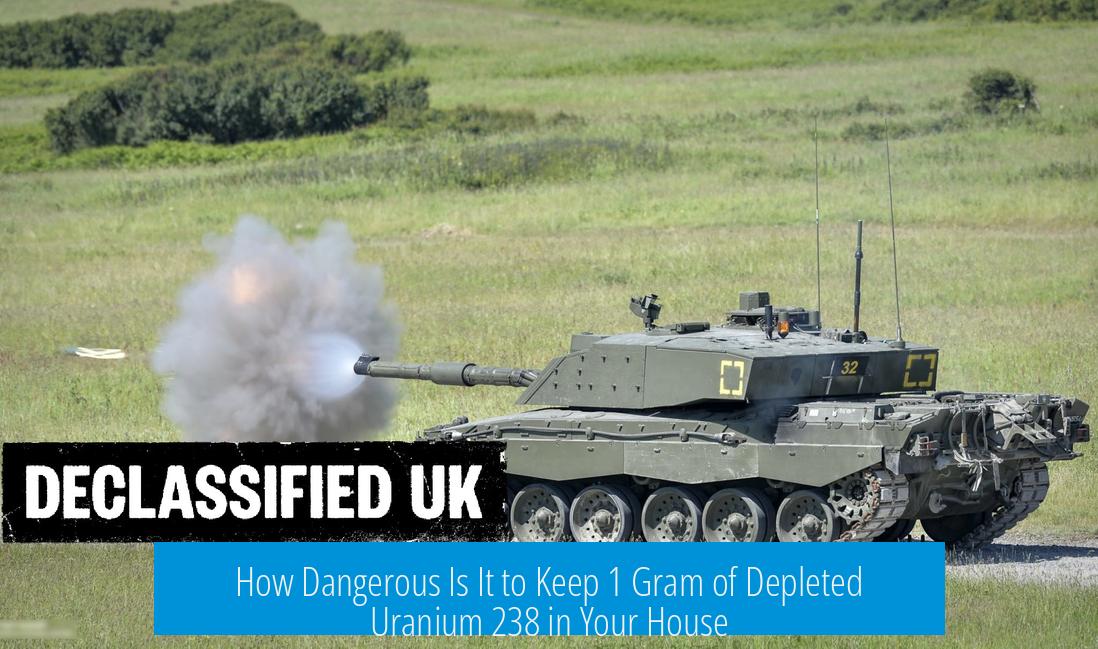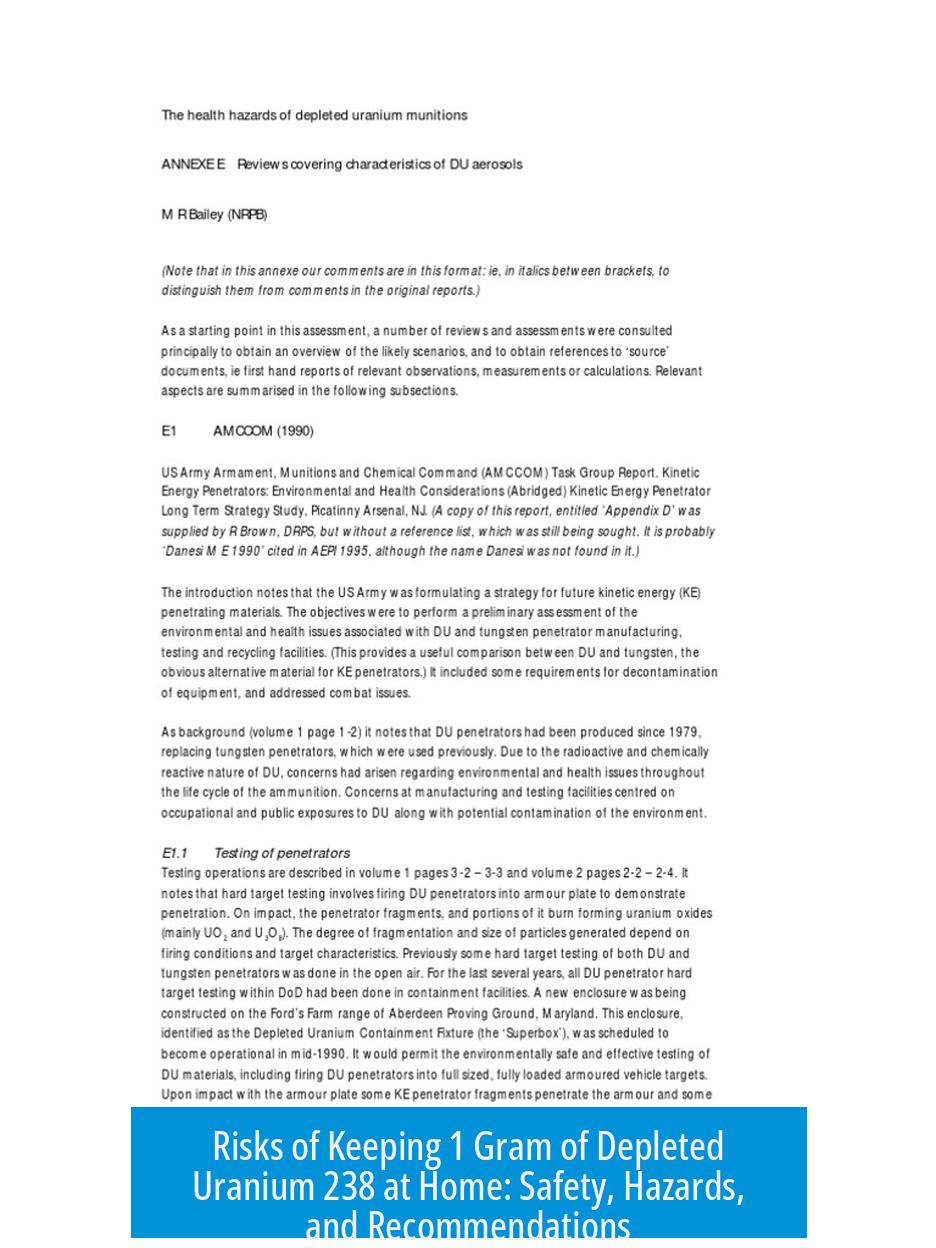How Dangerous Is It to Keep 1 Gram of Depleted Uranium 238 in Your House?

Keeping 1 gram of depleted uranium-238 (U-238) at home poses minimal radiation risk but carries chemical toxicity concerns and requires careful handling and legal consideration to ensure safety. The isotope emits low-level alpha radiation, easily blocked by skin. The main hazards arise from its chemical toxicity and potential flammability in metallic form. Proper containment and informed handling reduce risks significantly.
Understanding Radiation and Radioactivity Risks
Low Radioactivity of Depleted Uranium
Depleted uranium-238 has an extremely long half-life of about 4.5 billion years. This slow decay rate means it emits very little radiation at any given time. Its radioactivity level is comparable to that of many common rocks.
The radiation primarily consists of alpha particles, which cannot penetrate skin or most materials. This makes external exposure essentially harmless. Radiation exposure diverges from isotopes that emit beta or gamma radiation, which have greater penetrating power.
Type and Penetration of Radiation Emitted
- U-238 mainly emits alpha particles.
- Alpha particles cannot penetrate the outer dead layer of skin.
- Beta particles and gamma rays are not significantly emitted by depleted uranium, reducing external radiation concerns.
Because alpha radiation is not penetrating, the risk is only significant if uranium particles are ingested or inhaled. Intact, solid metallic uranium in a sealed container poses negligible radiation danger to occupants.
Exposure Risks Based on Form and Handling
The physical form affects safety. Solid lumps are safer than powders. Uranium powder can be inhaled or ingested, drastically increasing health risks due to internal radiation damage and chemical toxicity.
Direct skin contact with the material should be avoided. Simple precautions include not storing the uranium in a pocket or bare contact with skin for extended periods, eliminating any significant dose of ionizing radiation.
Sealing the uranium sample in glass or a robust container prevents radioactive dust dispersion, further lowering chemical and radiological hazard.
Legal and Regulatory Aspects
Ownership legality varies widely by jurisdiction. Some regions regulate possession of depleted uranium strictly, whereas others may allow small quantities without permits. Checking local regulations is essential before obtaining or storing any amount of uranium.
Chemical Toxicity and Physical Hazards
Toxicity of Uranium Metal
Chemically, uranium is a heavy metal and toxic if ingested or inhaled. It acts similarly to lead or mercury in biological systems, affecting kidneys and other organs.
Handling requires the same caution as other toxic metals—avoid eating, drinking, or inhaling dust after contact with uranium. Skin exposure to small amounts is less concerning but washing after handling is advised.
Children and pets increase risks as accidental ingestion or mishandling can occur. Uranium should not be kept in homes with vulnerable individuals.
Flammability of Metallic Uranium
In metallic form, uranium can be pyrophoric under the right conditions—it can ignite spontaneously in air. Although unlikely with only 1 gram to catch fire, risk exists particularly if the metal is finely divided or damaged.
To prevent combustion, storage under an inert atmosphere like nitrogen or argon is advisable. Avoid exposing metallic uranium to humid air or fine dust generation.
Safe Storage and Handling Recommendations
Effective Container Use
- Seal uranium in a glass or plastic vessel to prevent dust dispersion.
- Multiple containment layers reduce risk of accidental exposure or environmental contamination.
- Thick-walled containers block potential beta radiation—even if minimal—from escaping.
- Sealed ampoules or vials also preserve metal surface quality and reduce oxidation.
Best Practices in Handling
- Do not carry uranium containers next to skin for long periods (e.g., in pockets).
- Handle with gloves and wash hands thoroughly afterward.
- Store the uranium away from children or pets.
- Use it only in well-ventilated, controlled environments.
Following these simple rules keeps health risk from both radiation and chemical toxicity close to zero for small amounts.
Experience and Comparative Context
Historical Exposure and Common Uses
People have long used uranium compounds in industrial and decorative contexts. Uranium glassware, which contains uranium salts, has been crafted for nearly 2,000 years with no widespread health issues reported under normal use.
Professional handlers of depleted uranium, such as military or industrial workers, apply strict protocols and protective equipment to mitigate both chemical and radiological hazards encountered in larger quantities.
Professional Considerations and Caution
Radiation professionals emphasize that, despite low radiation, uranium’s dangers are real without appropriate controls. Exposure to uranium powder or prolonged direct contact can cause harm.
While depleted uranium’s low radioactivity poses limited external risk, its chemical toxicity and radioactivity demand respect and cautious handling in any context.
Summary of Risks and Safety Measures
| Aspect | Risk Level | Notes |
|---|---|---|
| Radiation Dose from 1g U-238 | Minimal | Alpha radiation blocked by skin, no penetrating radiation emitted |
| Chemical Toxicity | Moderate | Toxic if ingested or inhaled; avoid dust and ingestion |
| Fire Hazard | Low | Possible flammability in metallic uranium; inert storage recommended |
| Legal Considerations | Varies | Check local laws before possession or storage |
| Safe Handling | Essential | Use sealed containers, avoid direct contact and dust inhalation |
Key Takeaways
- Depleted uranium-238 emits low-level alpha radiation posing negligible external radiation risk.
- Chemical toxicity presents the main health hazard, especially from ingestion or inhalation.
- Handling solid U-238 in sealed containers greatly minimizes exposure risks.
- Metallic uranium can ignite under certain conditions; inert atmosphere storage enhances safety.
- Legal ownership depends on jurisdiction; confirm local regulations before keeping uranium.
- Following proper safety protocols, one gram of U-238 in a home is unlikely to be dangerous.
Is 1 gram of depleted uranium-238 radioactive enough to harm me at home?
Depleted uranium-238 emits mainly alpha particles that can’t penetrate skin. Its radioactivity is very low, similar to common rocks. Touching it briefly poses almost no radiation danger.
What is the main risk of keeping depleted uranium in my house?
The main risk is chemical toxicity, not radiation. Uranium is a heavy metal poison. Avoid breathing its dust, ingestion, or prolonged skin contact for safety.
How should I store 1 gram of depleted uranium safely?
Seal it tightly in glass or a thick plastic container. Avoid direct contact and keep it away from children. This prevents chemical and radiological contamination.
Could 1 gram of metallic depleted uranium catch fire in my home?
Metallic uranium can burn but 1 gram is a small amount. Still, keep it in an inert atmosphere like nitrogen or argon to reduce fire risk.
Do I need permission to keep 1 gram of depleted uranium at home?
Legal rules vary by location. Check local laws before owning depleted uranium to ensure it’s allowed and comply with regulations.





Leave a Comment